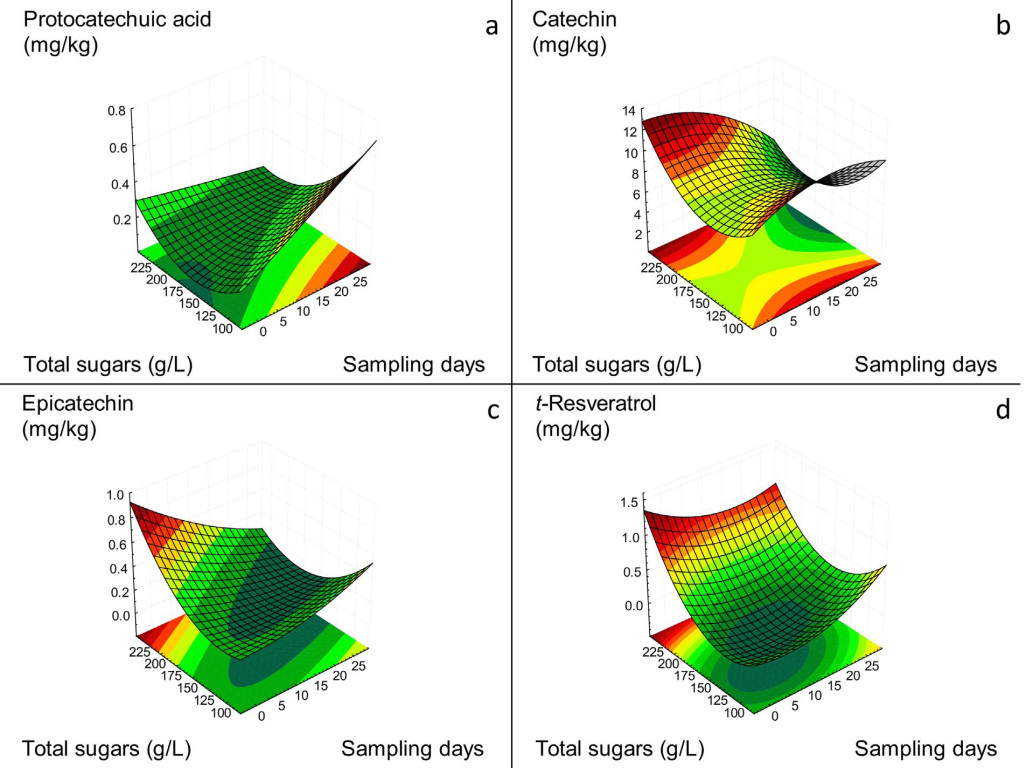Journal article published in Journal of Food Composition and Analysis, volume 62, pp. 14–22.
Authors: .
Abstract
The aim of this work was to determine the phenolic profile of Vitis vinifera L. cv. "Italia" table grapes during ripening, as influenced by the harvest date and berry heterogeneity. The results showed that this cultivar is rich in phenolic compounds with health-promoting properties, particularly at early harvest stage (341 and 178 mg/kg berries of total phenols in the skin and pulp, respectively). Caftaric acid was the most abundant compound in the skin (28.95–51.93 mg/kg), while p-coumaroyl-glucose was the highest in the pulp (6.39–17.18 mg/kg). Low levels of resveratrol (0.11–0.29 mg/kg) were found in the skin starting from day 14 of the harvest. Response surface methodology (RSM) was used to model the evolution of phenolic compounds in berries during ripening. The regression models were highly significant for protocatechuic acid, catechin, epicatechin and t-resveratrol in the skin, and total hydroxycinnamoyl tartaric acids in the pulp (R ≥ 0.80). This modeling could be a tool that would permit better exploitation of maximum accumulation of phenolic compounds in the vineyard by selecting the most suitable combination of sampling date and berry density. An adequate sampling strategy could be implemented to increase the content of specific bioactive phenolic compounds according to consumer preference, thus promoting the health-promoting quality of fresh table grapes and ready-to-eat fruit salads.
Key words berry density; epicatechin; ferulic acid; HCTA index; HPLC-MS/MS; resveratrol; ripening; table grapes; Vitis vinifera
BibTeX entry: click to show
@article{
2318_1641053,
url = {https://hdl.handle.net/2318/1641053},
author = {Belviso, Simona and Torchio, Fabrizio and Novello, Vittorino and Giacosa, Simone and de Palma, Laura and Río Segade, Susana and Gerbi, Vincenzo and Rolle, Luca},
title = {Modeling of the evolution of phenolic compounds in berries of ``Italia'' table grape cultivar using response surface methodology},
year = {2017},
journal = {Journal of Food Composition and Analysis},
volume = {62},
abstract = {The aim of this work was to determine the phenolic profile of Vitis vinifera L. cv. ``Italia'' table grapes during ripening, as influenced by the harvest date and berry heterogeneity. The results showed that this cultivar is rich in phenolic compounds with health-promoting properties, particularly at early harvest stage (341 and 178 mg/kg berries of total phenols in the skin and pulp, respectively). Caftaric acid was the most abundant compound in the skin (28.95–51.93 mg/kg), while p-coumaroyl-glucose was the highest in the pulp (6.39–17.18 mg/kg). Low levels of resveratrol (0.11–0.29 mg/kg) were found in the skin starting from day 14 of the harvest. Response surface methodology (RSM) was used to model the evolution of phenolic compounds in berries during ripening. The regression models were highly significant for protocatechuic acid, catechin, epicatechin and t-resveratrol in the skin, and total hydroxycinnamoyl tartaric acids in the pulp (R ≥ 0.80). This modeling could be a tool that would permit better exploitation of maximum accumulation of phenolic compounds in the vineyard by selecting the most suitable combination of sampling date and berry density. An adequate sampling strategy could be implemented to increase the content of specific bioactive phenolic compounds according to consumer preference, thus promoting the health-promoting quality of fresh table grapes and ready-to-eat fruit salads.},
keywords = {berry density; epicatechin; ferulic acid; HCTA index; HPLC-MS/MS; resveratrol; ripening; table grapes; Vitis vinifera},
doi = {10.1016/j.jfca.2017.04.006},
pages = {14--22}
}
Publication availability
Accepted manuscript
This file is available in an accepted manuscript version from the IRIS institutional repository.
This file is subjected to usage limitations according to its license.
View or request this publication
You can find the postprint version of this article in the Open Access Repository of the University of Torino:
IRIS-AperTO record 2318/1641053
View the final version at publisher:
doi:10.1016/j.jfca.2017.04.006
File not available? Do you need further information?
You can contact me and request this article through the following form:
